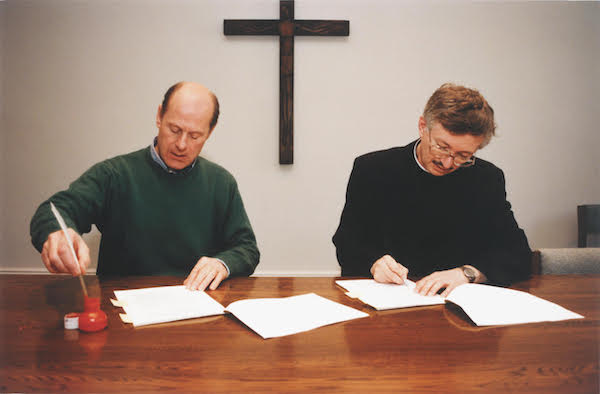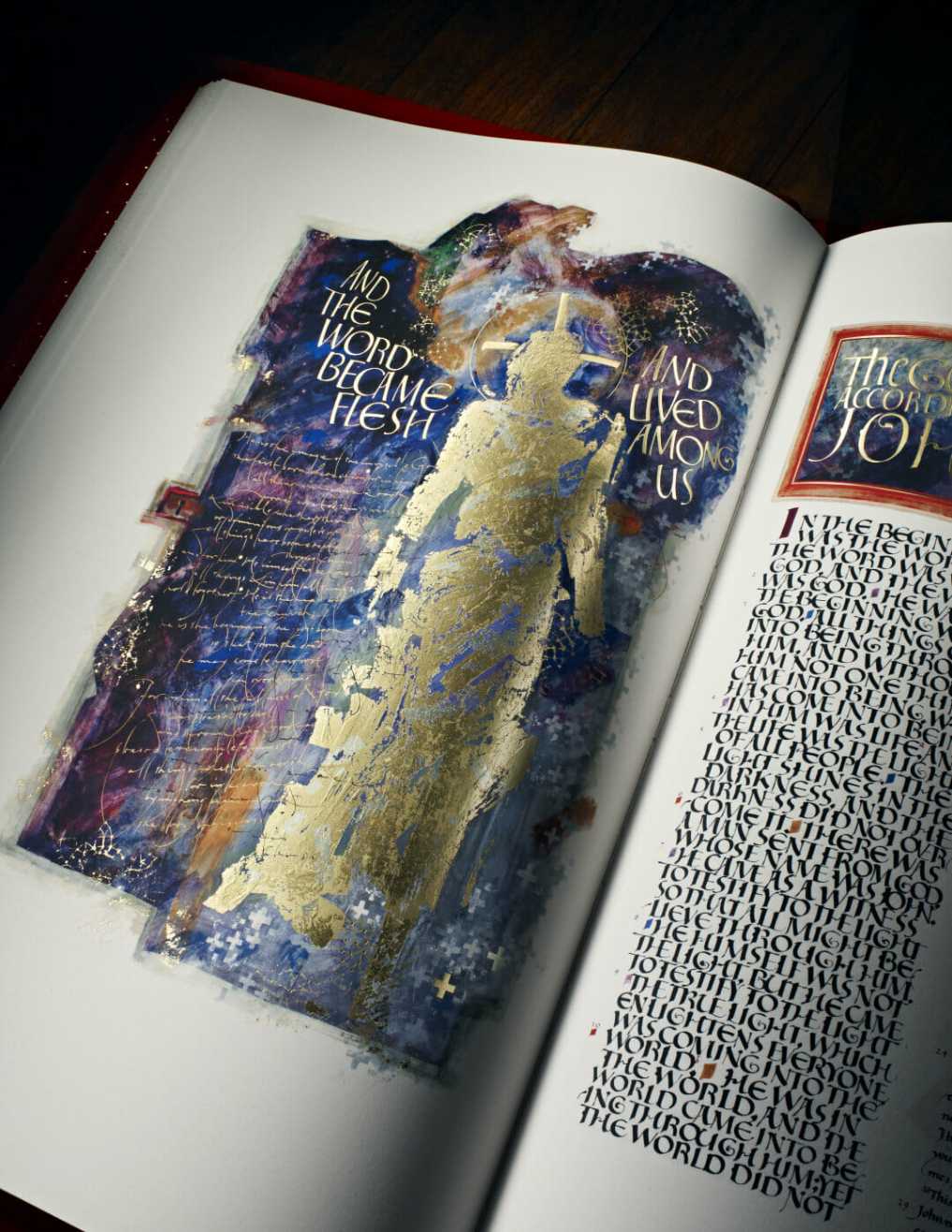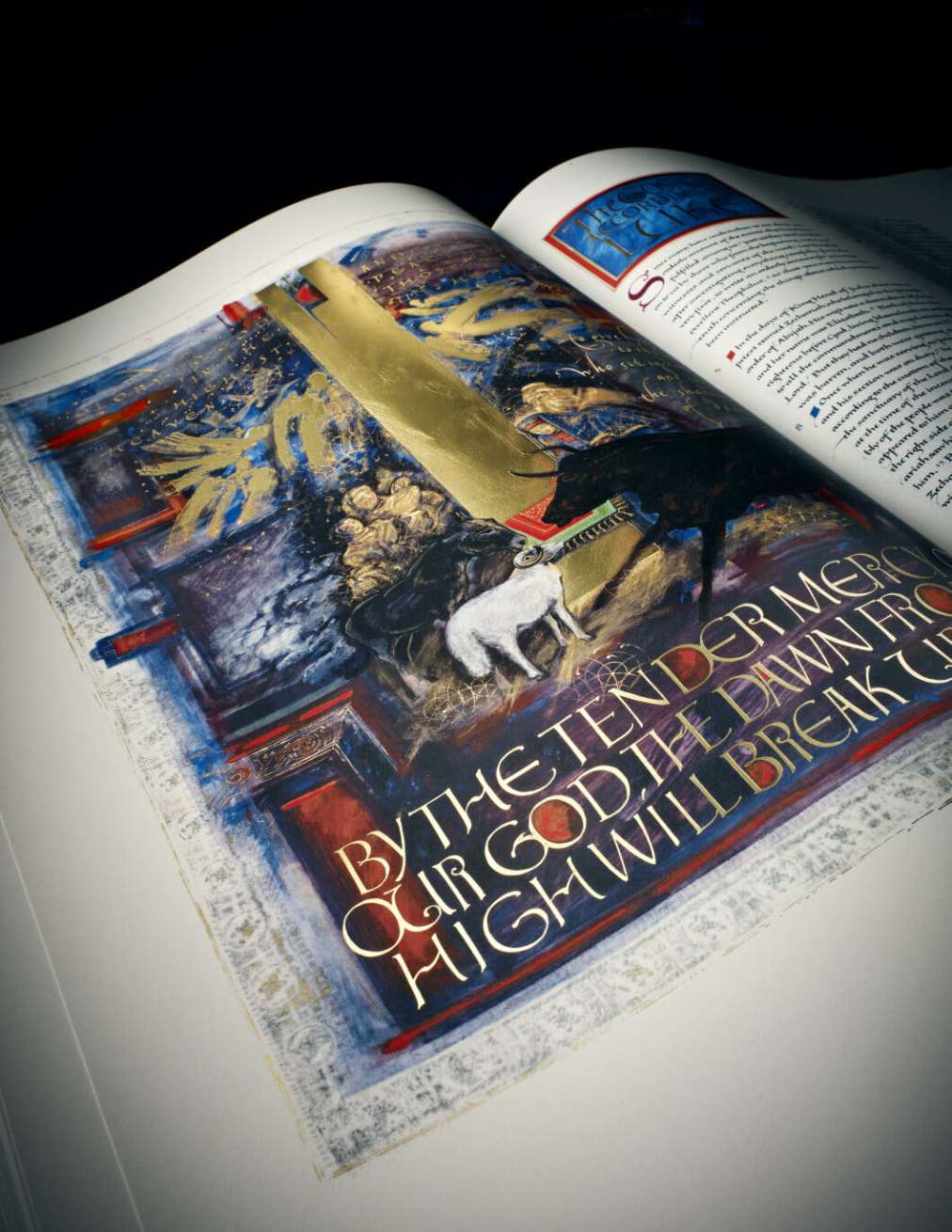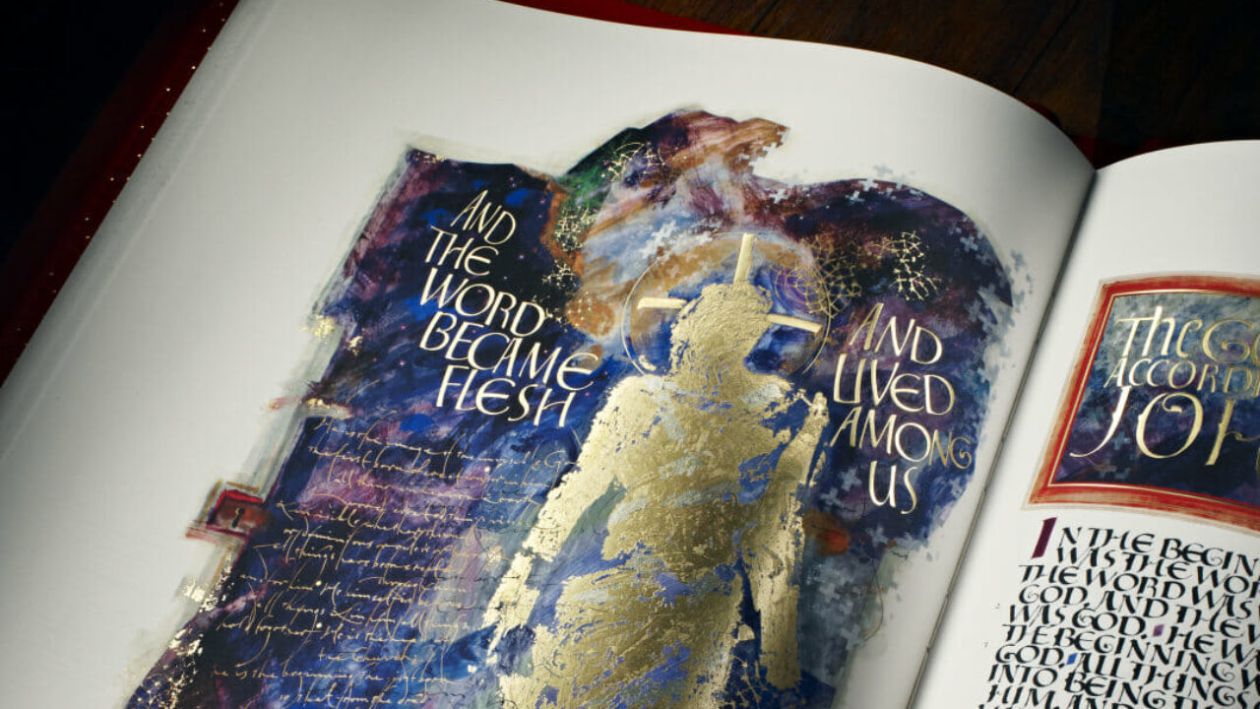Celebrating the 25th Anniversary of the Commissioning of The Saint John’s Bible
First completely handwritten and hand-illuminated Bible to be commissioned by a Benedictine abbey since the invention of the printing press 500 years ago.
Collegeville, Minnesota Since it was commissioned 25 years ago, The Saint John’s Bible has touched millions of people around the world. Completed in 2011, it inspires. It heals. And, to its original intent, it brings people together.
It’s this spirit the spirit of bringing people together that may be the most remarkable aspect of this story. Because it is here, in a moment of time, where Donald Jackson, a Welsh calligrapher known as the scribe for Her Majesty Queen Elizabeth II and the House of Lords, connected with a group of Benedictine monks in central Minnesota, to embark on a monumental masterpiece the creation of the first completely handwritten and hand-illuminated Bible to be commissioned by a Benedictine abbey since the invention of the printing press 500 years ago – an undertaking not likely to ever be attempted again.
April 28, 2023, marks the 25th anniversary of when Donald Jackson met with Br. Dietrich Reinhart, OSB, at Saint John’s University and signed an agreement commissioning the creation of The Saint John’s Bible.

And while it would take another 13 years until the project was complete, for Donald Jackson, it was the fulfillment of a childhood dream to create a handwritten, illuminated Bible. On Ash Wednesday, March 8, 2000, Jackson would scribe the first words at his scriptorium (workshop) near his home in Monmouth, Wales.
“In 1998, making the words of the Scriptures come alive on the pages of The Saint John’s Bible was a lifetime’s dream and a fearful, intensely personal challenge,” said Donald Jackson from his home and workshop in Monmouth, Wales. “It became a creative journey which relied on the talented works of many hands and hearts. Theologians, scribes and scholars, illuminators, parchment makers, administrators, helpmates, benefactors, and friends all combined over many years to make the dream become a reality.
“Our task was to ignite the spiritual imagination,” Jackson added. “Twenty-five years on, The Saint John’s Bible and the printed volumes of the Heritage Edition have now taken on a life of their own around the world. What better reason can there be for a celebration!”
A Connection Leads to a Masterpiece
Jackson’s relationship with the Benedictine monks at Saint John’s Abbey and Saint John’s University, a private, four year liberal arts university, trace themselves back to 1981, when Jackson served as the keynote speaker at a global calligraphers conference at Saint John’s University in Collegeville, Minnesota, located about 90 minutes northwest of Minneapolis-St. Paul. Later, in 1995, Jackson, while having lunch with Fr. Eric Hollas, OSB, director of the Hill Museum and Manuscript Library, at a conference in Chicago, suggested that the monks of Saint John’s Abbey consider creating a hand written bible as way to mark the New Millennium.

Twenty-five years may seem like a lifetime ago in today’s digital age, but in the continuation of the Order of Saint Benedict, it is a merely a whisper of time. Founded in AD 529, at the monastery at Montecassino, Italy, the Benedictines have maintained a 1,500 year tradition of bringing beauty and sacred art into the world, while defining, sharing and preserving selected works of European literature.
In an age defined by the internet, Google Search, online media and advances in artificial intelligence, The Saint John’s Bible captured international attention with its intent to unite an ancient Benedictine tradition with modern technology to illuminate the World of God for a new generation and generations to come.
A Monumental Effort
The Saint John’s Bible is a work of art and theology monumental in its scope and desired reach. In the tradition of great medieval Bibles, The Saint John’s Bible is two feet tall and three feet wide. It consists of 1,100+ pages that were written on calfskin vellum using turkey, goose and swan quills. It has more than 160 hand illuminations and numerous special text treatments. The team of scribes used ancient natural inks, hand ground pigments, and gold and silver leaf gild.
In making the project public in 1999, Saint John’s said the purpose behind The Saint John’s Bible was: “At the onset of a new millennium, Saint John’s University and the monks of Saint John’s Abbey sought to ignite the spiritual imagination of people throughout the world by commissioning a work of art that illuminates the world today.
“This monumental project of sacred Word and Art, has had, and continues to have, a transformational impact on people of many faith traditions across the world,” said Rev. Dr. John F. Ross, the Executive Director of The Saint John’s Bible Heritage Program at Saint John’s University in Collegeville. “There are more than 160 locations around the world where one can experience it, from houses of worship to hospitals and college libraries. The Saint John’s Bible brings together people, providing illumination, inspiration and healing.”

The Saint John’s Bible is based on the New Revised Standard Version (NRSV), a modern English translation with a strong literal tradition. It consists of 73 books of the Old and New Testaments which have been collected into seven volumes: Gospels and Acts, Pentateuch, Psalms, Prophets, Wisdom Books, Historical Books, and Letters and Revelation.
In the spirit of collaboration, a team of artists coordinated by Donald Jackson in Wales and a team of scholars in Minnesota brought together the ancient techniques of calligraphy and illumination with an ecumenical approach to the Bible rooted in Benedictine spirituality (hospitality, transformation, and justice for God’s people). Approximately 23 artists and calligraphers completed their work on the original manuscripts over a period of 11 years.
A Gift That Keeps on Giving
From day one, the intention behind creating The Saint John’s Bible has been, and always will be, to share the sacred Word of God. Since its completion, Saint John’s continues to make The Saint John’s Bible available to more and more people each year. And in turn, the gift made possible through the monks of Saint John’s as well as a number of benefactors, continues to keep on giving. Because it is unlike any other modern-day Bible, The Saint John’s Bible acts like a magnet, bringing together people of all faiths.
The original The Saint John’s Bible is housed at the Hill Museum and Manuscript Library (HMML) at Saint John’s University in Collegeville, Minnesota, on the grounds of Saint John’s Abbey. Pages from the original manuscript are always on exhibition in the HMML gallery, which is free and open to the public. In addition, twelve Apostle limited editions are housed in the permanent collections at the Library of Congress, the Morgan Library, and the Vatican Museum of Art, among others.
For most people, their first experience with The Saint John’s Bible begins when they see one of the 160 full size, museum-quality, fine art reproductions of the original seven volumes, which are known as the Heritage Edition. communities around the world in North America, Australia, the United Kingdom, Europe and Hong Kong.
Available to individuals and institutions, The Saint John’s Bible Heritage Edition brings together worship communities such as Trinity Episcopal Church in Galveston, TX, or parishes within a diocese, such as the Diocese of Hamilton, Ontario. It brings healing in hospitals such as the Mayo Clinic in Rochester, Minnesota, or Saint Alphonsus Regional Medical Center in Boise, Idaho. And it is being used for study at educational institutions such as Brigham Young University, Arizona State University and Gonzaga University.
While the use of The Saint John’s Bible Heritage Edition may vary from place to place, what remains is the awe this work inspires igniting the spiritual imagination of people from all faith journeys.
As for the next 25 years, the future is bright as new technology will create more opportunities to share this beautiful, monumental work with the next generation.
To learn more about The Saint John’s Bible, visit this page.


